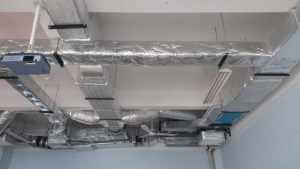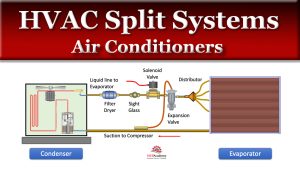
Key components and features of a central air-conditioning system include:
Central Cooling Unit (Condenser): The central cooling unit, often located outside the building, contains the compressor, condenser coils, and fans. It is responsible for extracting heat from indoor air and releasing it outdoors, effectively cooling the air in the process.
Evaporator Coil: The evaporator coil, typically located within the building’s air handler or furnace, is responsible for absorbing heat from indoor air as it passes over the coil. The heat absorbed by the evaporator coil is then transferred to the condenser unit for release.
Ductwork: Ductwork consists of a network of sealed and insulated channels that distribute cooled air throughout the building. Air is pushed or pulled through the ducts by a blower or fan, ensuring even distribution of cooled air to various rooms and areas.
Thermostat: A thermostat serves as the control interface for the central air-conditioning system. It allows users to set the desired temperature and control the system’s operation modes, such as cooling, fan speed, and scheduling.
Air Handler: The air handler is responsible for circulating air through the evaporator coil and distributing cooled air through the ductwork. It also houses the blower or fan that propels air into the ducts.
Refrigerant: Refrigerant is the substance that absorbs and releases heat during the cooling cycle. It circulates between the evaporator coil and the condenser unit, changing from a gas to a liquid and back to a gas as it absorbs and releases heat.
Filters and Air Purification: Central air-conditioning systems often include filters that trap dust, allergens, and other particles, improving indoor air quality. Some systems also offer additional air purification options to enhance air quality further.
Zoning: Zoning systems allow different areas of the building to be cooled independently. This feature can help save energy by only cooling occupied areas.
Energy Efficiency: Central air-conditioning systems have evolved to include energy-efficient technologies, such as variable-speed compressors, smart thermostats, and programmable controls, to optimize cooling and reduce energy consumption.
Maintenance and Service: Regular maintenance, including filter replacement, coil cleaning, and system inspections, is essential to ensure the system’s efficiency, longevity, and reliable operation.
Central air-conditioning systems offer a convenient and effective way to cool larger spaces, providing consistent comfort and temperature control. They are suitable for various applications, from residential homes to commercial buildings, and can contribute to improved indoor air quality and overall well-being. Proper installation, maintenance, and operation are essential to maximize the benefits of a central air-conditioning system while minimizing energy usage and environmental impact.

Key features and components of a split type air-conditioning system include:
Indoor Unit (Evaporator): The indoor unit contains the evaporator coil, blower or fan, and air filters. It is installed inside the room or area to be cooled. The indoor unit is responsible for absorbing heat from indoor air and releasing cooled air back into the space.
Outdoor Unit (Condenser): The outdoor unit houses the compressor, condenser coils, and a fan. It is typically installed outside the building and is responsible for dissipating the heat absorbed from indoor air into the outdoor environment.
Refrigerant Lines: Refrigerant lines connect the indoor and outdoor units, allowing the refrigerant to circulate between them. Refrigerant absorbs heat from indoor air at the evaporator coil and releases it at the condenser unit.
Remote Control: Split type air-conditioners come with a remote control that allows users to adjust settings such as temperature, fan speed, mode (cooling, heating, dehumidifying), and timer functions.
Installation Flexibility: Split type air-conditioners offer flexibility in installation since the indoor and outdoor units are connected by refrigerant lines and require minimal ductwork. This makes them suitable for retrofitting into existing spaces or areas where ductwork is not feasible.
Zoning and Multi-Split Systems: Some split type systems offer zoning capabilities, allowing different indoor units to be controlled independently. Multi-split systems can connect multiple indoor units to a single outdoor unit, providing cooling to multiple rooms or areas.
Energy Efficiency: Many modern split type air-conditioners are designed with energy-efficient features, such as inverter technology, which adjusts the compressor speed to maintain a consistent temperature and reduce energy consumption.
Compact Design: The compact design of split type air-conditioners makes them aesthetically pleasing and less obtrusive compared to some other cooling solutions.
Installation Considerations: Proper installation is crucial for optimal performance. Indoor units should be placed strategically for even cooling, and outdoor units should have proper ventilation to ensure efficient heat dissipation.
Maintenance: Regular maintenance, including cleaning air filters, checking refrigerant levels, and cleaning the outdoor unit, is important to maintain system efficiency and longevity.
Split type air-conditioning systems offer a versatile and efficient solution for cooling specific areas or rooms, allowing occupants to customize their comfort while conserving energy. They are commonly found in residential bedrooms, living rooms, offices, and small commercial spaces, offering reliable and convenient cooling during hot weather.

Key features and components of a ventilation system include:
Air Intake: Fresh outdoor air is drawn into the building through air intake openings, such as vents or louvers. The location and design of these openings are important for optimizing air quality and minimizing outdoor pollutants.
Air Distribution: The ventilation system distributes fresh air to various rooms and areas within the building using a network of ducts, fans, and vents. Air distribution ensures even airflow and proper ventilation throughout the space.
Exhaust: Stale indoor air, pollutants, and excess moisture are expelled from the building through exhaust vents or ducts. Exhaust systems remove indoor contaminants and prevent the buildup of odors and pollutants.
Fans and Blowers: Fans and blowers are used to facilitate the movement of air within the ventilation system. They help create positive or negative pressure within the building to control airflow and air exchange rates.
Air Filters: Air filters are installed within the ventilation system to remove particles, allergens, and pollutants from the incoming outdoor air. Filters improve indoor air quality by trapping dust, pollen, and other contaminants.
Heat Recovery Systems (HRV/ERV): Heat recovery ventilation (HRV) and energy recovery ventilation (ERV) systems are designed to exchange heat between outgoing and incoming air streams, helping to maintain energy efficiency while providing fresh air.
Controls and Sensors: Ventilation systems often include controls and sensors that monitor indoor air quality, temperature, and humidity. These sensors help regulate ventilation rates and ensure optimal air exchange.
Types of Ventilation Systems:
Ductwork: Ductwork is used to distribute and transport fresh air and exhaust air throughout the building. Properly designed and sealed ductwork ensures efficient and balanced airflow.
Maintenance: Regular maintenance, including cleaning filters, checking fans and blowers, and inspecting ductwork, is important to ensure the effective operation and longevity of the ventilation system.
Ventilation systems play a crucial role in maintaining a healthy and comfortable indoor environment by promoting adequate air exchange and reducing the accumulation of indoor pollutants. Properly designed and maintained ventilation systems contribute to improved occupant well-being and overall building performance.
Please feel free to contact us. We will get back to you with 1-2 business days. Or just call us now
WhatsApp us
